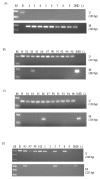Frequent promoter hypermethylation of RASSF1A and CASP8 in neuroblastoma
- PMID: 17064406
- PMCID: PMC1634754
- DOI: 10.1186/1471-2407-6-254
Frequent promoter hypermethylation of RASSF1A and CASP8 in neuroblastoma
Abstract
Background: Epigenetic alterations and loss of heterozygosity are mechanisms of tumor suppressor gene inactivation. A new carcinogenic pathway, targeting the RAS effectors has recently been documented. RASSF1A, on 3p21.3, and NORE1A, on 1q32.1, are among the most important, representative RAS effectors.
Methods: We screened the 3p21 locus for the loss of heterozygosity and the hypermethylation status of RASSF1A, NORE1A and BLU (the latter located at 3p21.3) in 41 neuroblastic tumors. The statistical relationship of these data was correlated with CASP8 hypermethylation. The expression levels of these genes, in cell lines, were analyzed by RT-PCR.
Results: Loss of heterozygosity and microsatellite instability at 3p21 were detected in 14% of the analyzed tumors. Methylation was different for tumors and cell lines (tumors: 83% in RASSF1A, 3% in NORE1A, 8% in BLU and 60% in CASP8; cell lines: 100% in RASSF1A, 50% in NORE1A, 66% in BLU and 92% in CASP8). In cell lines, a correlation with lack of expression was evident for RASSF1A, but less clear for NORE1A, BLU and CASP8. We could only demonstrate a statistically significant association between hypermethylation of RASSF1A and hypermethylation of CASP8, while no association with MYCN amplification, 1p deletion, and/or aggressive histological pattern of the tumor was demonstrated.
Conclusion: 1) LOH at 3p21 appears in a small percentage of neuroblastomas, indicating that a candidate tumor suppressor gene of neuroblastic tumors is not located in this region. 2) Promoter hypermethylation of RASSF1A and CASP8 occurs at a high frequency in neuroblastomas.
Figures



References
-
- Schawb M, Shimada H, Joshi V, Brodeur GM. Pathology and genetics of tumours of the nervous system. World health organization classification of tumours. Lyon, IARC Press. 2000. pp. 153–161.
-
- Agathanggelou A, Dallol A, Zochbauer-Muller S, Morrissey C, Honorio S, Hesson L, Martinsson T, Fong KM, Kuo MJ, Yuen PW, Maher ER, Minna JD, Latif F. Epigenetic inactivation of the candidate 3p21.3 suppressor gene BLU in human cancers. Oncogene. 2003;22:1580–1588. doi: 10.1038/sj.onc.1206243. - DOI - PubMed
-
- Lerman MI, Minna JD. The 630-kb lung cancer homozygous deletion region on human chromosome 3p21.3: identification and evaluation of the resident candidate tumor suppressor genes. The International Lung Cancer Chromosome 3p21.3 Tumor Suppressor Gene Consortium. Cancer Res. 2000;60:6116–6133. - PubMed
Publication types
MeSH terms
Substances
LinkOut - more resources
Full Text Sources
Medical
Miscellaneous

